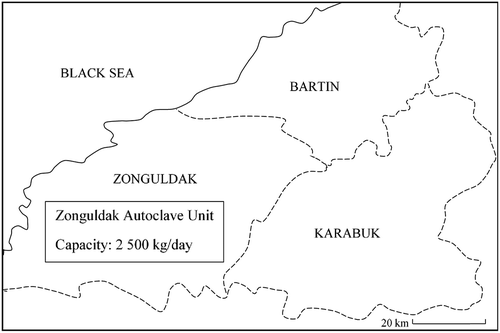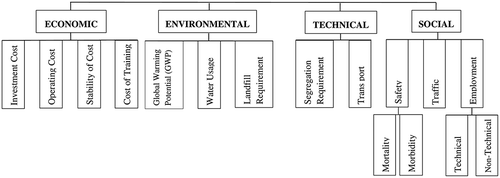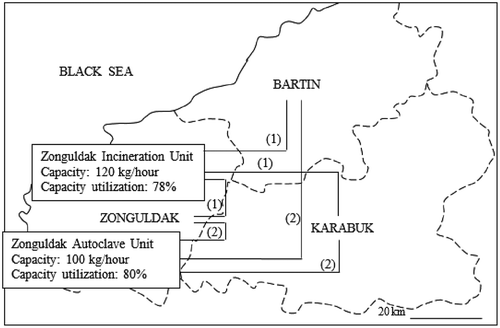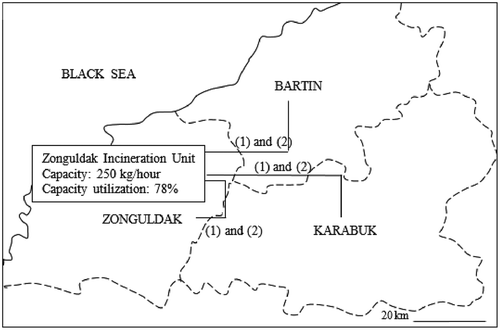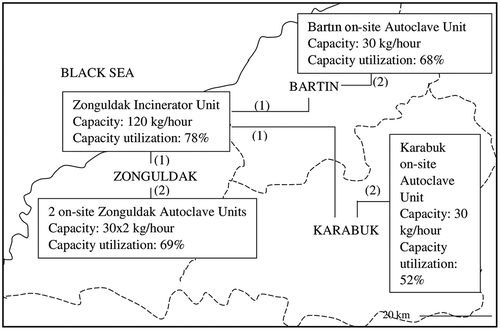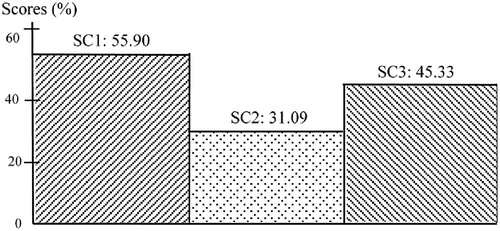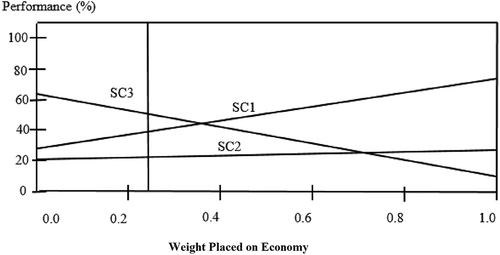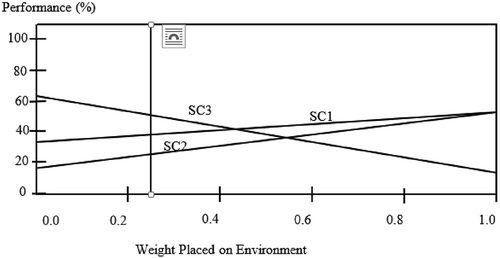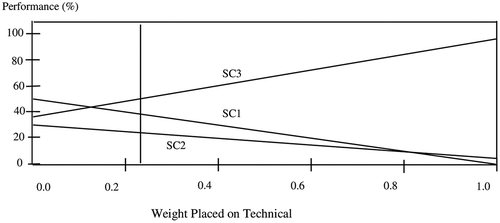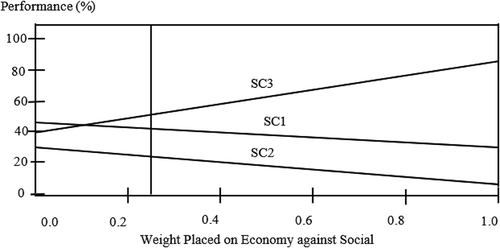Abstract
The aim of this paper is to identify the best possible health care waste management option in the West Black Sea Region by taking into account economic, social, environmental, and technical aspects in the concept of multi-criteria decision analysis. In the scope of this research, three different health care waste management scenarios that consist of different technology alternatives were developed and compared using a decision-making computer software, called Right Choice, by identifying various criteria, measuring them, and ranking their relative importance from the point of key stakeholders. The results of the study show that the decentralized autoclave technology option coupled with the disposal through landfilling with energy recovery has potential to be an optimum option for health care waste management system, and an efficient health care waste segregation scheme should be given more attention by the authorities in the region. Furthermore, the discussion of the results points out multidisciplinary approach and the equilibrium between social, environmental, economic, and technical criteria. The methodology used in this research was developed in order to enable the decision makers to gain an increased perception of a decision problem. In general, the results and remarks of this study can be used as a basis of future planning and anticipation of needs for investment in the area of health care waste management in the region and also in developing countries that are dealing with the similar waste management problems.
Implications: Alternative technologies are not capable to treat some categories of health care wastes, and Turkish practice has to be revised urgently. In doing so, internal health care waste separation is critical for determination of treatment technology. The author verified the methodology in a decision-making framework for a real-world problem. Results indicated that incinerating all health care wastes is not a feasible option due to high cost.
Introduction
Since the detrimental impacts of inadequate management of health care waste (HCW) were understood by the environmental agencies, adoption of proper HCW service has become a priority for regulatory agencies across the world (Ciplak and Barton, Citation2012; Moreira et al., Citation2013). In Turkey, the accession to European Union (EU) requires compliance with the EU legislation. Currently, there is an increasing pressure on the Turkish government authorities to develop a sustainable approach to HCW management and integrate strategies aiming at pursuing sustainable society. For this reason, HCW, for the first time, came under the regulation of the Ministry of Environment and Forestry with the Turkish Medical Waste Control Regulation (TMWCR) in 1993 and was upgraded in 2005 (Turkish Ministry of Environment and Forestry, Citation2005).
However, these regulatory studies on HCW have not accordingly resulted in practicing activities at health institutions. For instance, it is stated in the TMWCR that the wastes generated at health institutions are classified under three main groups: municipal waste, HCW, and hazardous waste. HCW is further divided into infectious waste, pathological waste, and sharps, whereas hazardous waste includes pressurized container waste, waste containing heavy materials, pharmaceutical waste, genotoxic waste, and hazardous health care chemicals. This classification also differs from the HCW categorization provided by the World Health Organization (WHO; Citation2014), which divides the HCW stream into two groups according to its hazardous nature.
Although the TMWCR stipulates that hazardous waste must be collected separately and should be regulated under the hazardous waste regulations (Article 14), in practice there are only a few private health institutions (holding accredited quality certificate) that collect their hazardous wastes separately from HCW. The rest of the institutions mix their HCW and hazardous wastes together in the HCW bags with the exception of sharps, which are accumulated in rigid containers. Radioactive wastes are collected and disposed of separately by the Turkish Atomic Institute.
The other significant issue with the HCW sector is that there is currently a wide turn to steam sterilization technologies (such as autoclaves), which are traded by many Turkish private companies. Also in the literature, most of the studies conducted so far have pointed out an urgent need for alternative technologies to be built up (Alagoz and Kocasoy, Citation2008; Birpinar et al., Citation2009; Eker and Bilgili, Citation2011). However, the sterilization technologies are not technically applicable to some categories of HCW, for example, cytotoxic, anatomic, and pharmaceutical wastes (Ciplak and Barton, Citation2012). The only treatment method for these types of HCW is an incineration (European Council, Citation1991; European Council, Citation2000). Without addressing the HCW segregation schemes (such as incineration-only HCW and HCW suitable for alternative treatment [HCW SAT]) at health institutions, it is not possible to treat HCW without putting human health and the environment at risk. For this reason, more research is required to establish a database, information, and statistics on HCW composition to develop robust models that enable the impact of segregation schemes to be assessed and predict the potential for introducing new technologies.
Today, there is a growing interest on the issue of proper and integrated treatment of infectious HCW in Turkey and especially so in the West Black Sea Region. Significant investments for the improvement of infrastructure are anticipated. In this context, effective planning and integrated assessment of these technologies are necessary with appropriate methodologies and tools such as multi-criteria decision analysis (MCDA) to aid stakeholders in this sector.
Following review of past and current information in Turkey and the relevant research in other countries, this study takes a case-study approach based on the HCW management in the West Black Sea Region with the objectives of (1) to establish the current status of HCW management in the region to determine the uncertainties and gaps involved in the system; and (2) to identify the criteria in the HCW decision-making process to establish their importance (relative importance) for ultimate decision making.
Literature Review
In many developing countries, specific rules and regulations have been implemented along with the recommendations for handling (collection-transportation-treatment-disposal). In parallel with the improvements in the HCW sector, waste management decision making in developing countries has moved towards being more pragmatic, transparent, sustainable, and comprehensive. However, it has been recognized that a fully quantitative approach in decision making is difficult to apply in the context of developing countries due to lack of information and variety of data. Likewise, the comprehensiveness of the method to be adopted is also restricted by the nature of local specific environmental and social issues.
A broad range of decision analysts emphasized that the most important advantage of MCDA over other methods (such as cost-benefit analysis) is its capability of dealing with social criteria, which is a necessity for sustainability. The methodological framework of MCDA is well suited to the complex nature of environmental decision making; more specifically, waste management decision analysis in terms of the following: (1) It can deal with mixed sets of data, quantitative and qualitative (Liu et al., Citation2015). This aspect is a distinct advantage especially for developing countries where the data are scarce or include uncertainty (Garfì et al., Citation2009; Wang et al., Citation2009). (2) It is conveniently structured to enable a collaborative planning and decision-making environment. This allows the direct involvement of multiple experts, interest groups, and stakeholders. It is transparent to participants, and it provides a focus for working through the decision problem by breaking it down (Goodwin and Wright, Citation2004). (3) The main benefit is that MCDA provides a better understanding of the decision to be made by accommodating stimulation of discussion and sharing of others’ ideas in a structured way. This benefit is particularly significant for group decisions (Dooley et al., Citation2009; Dursun et al., Citation2011). Petts (Citation2000) encouraged MCDA techniques to be used by concluding that “Such approaches incorporating multi criteria analysis are more consistent with the objectives of resolving problems as they force values and problem framing to be made transparent.” For these reasons, the MCDA technique was employed in this study to improve the regional HCW management decision-making mechanism to make it environmentally, economically, and technically sound, and socially viable.
Social and Environmental Background
This study focuses on the West Black Sea Region covering three provinces: Zonguldak, Karabuk, and Bartin, with an estimated population of 1.5 million (Turkstat, Citation2013). The West Black Sea Region (with the provinces of Zonguldak, Karabuk, and Bartin) is included in the “Priority Development Areas” by the Turkish Ministry of Development (Citation2006).
There is no segregation of incineration-only HCW and HCW SAT in the region. All the HCW produced in the region (almost 1 000 tons yr−1) is treated in Zonguldak Autoclave Unit, which is the only facility in the region with a 2500 kg/day capacity ().
Methodology: MCDA for HCW Management
In order to improve the regional HCW management decision-making mechanism in a way of being environmentally, economically, and technically sound and socially viable, the MCDA technique was employed in this study. The analysis of the results was made by using a decision-making computer tool, Right Choice, which is a decision support tool for multi-criteria value measurement based on stakeholder judgments about the difference in attractiveness between two criteria in order to generate numerical scores for the options (scenarios) in each criterion and to weight the criterion, as explained and detailed below. It was designed for the situations where multiple choices exist and it is wished to select the optimum option. The software is able to process data and translate them into relevant information for the use of decision makers.
In this study, three scenarios were identified and each scenario was assessed against a number of criteria in a decision tree. Each criterion was then allocated a weighting relative to the others based on its importance by using a questionnaire. This analysis was conducted in five steps as below:
A decision tree and the scenarios were built up (Section: “A regional decision tree and the scenarios”).
A number of analyses were conducted to measure how well each scenario performs on each criterion in the decision tree (Section: “Measurement of the criteria”).
Stakeholders who act in the HCW management system were identified.
A questionnaire was prepared and sent to the stakeholders in order to assign relative weights to the identified criteria. This enabled comparing the values allocated to one criterion with the values contributed to others (Section: “Identification of stakeholders and assigning relative weights”).
Resulted outcomes were inputted in decision-making software tool to test out how well each scenario performs overall and how sensitive the HCW management system is to any change in the score of the identified criteria (Section: “Results”).
In this study, a relative weighting procedure was used by assigning monetary values to the savings that appear by preferring the best scenario (the scenario that performs best on that criterion) to the worst scenario. The steps of this procedure are as follows:
Step 1: Stakeholder’s value, as a nominal unit of each criterion in terms of monetary value, was gathered via the questionnaire. For instance, how much do you think it is worth saving 1 ton of CO2? Stakeholder’s value, for example, on 1 ton of CO2-e (CO2 equivalent) is €10. (Represented as fi.)
Step 2: An average of stakeholders’ value was calculated (as shown in eq 1).
Step 3: The performance of the three scenarios on each criterion in the decision tree was measured as explained in the section “Measurement of the criteria.” For example, CO2-e emissions of the three scenarios (SC1, SC2, and SC3) were 200, 100, and 600 tons, respectively.
Step 4: In order to assign relative weightings to each criterion, the scenario that performed best on this criterion and the scenario that performed worst were chosen and the differences between these performances were converted to monetary values. For example, value of 1 ton of CO2-e is €10 (average fi) and the difference between the best and worst scenario’s performance (best versus worst) on global warming potential (GWP) was 500 tons CO2-e (difference between 600 and 100 tons). The monetary weight of the criterion of “global warming potential” was calculated as €5 000 (€10 times 500 tons).
Step 5: Once the monetary weighting procedure was completed for all the criteria in one branch of the decision tree, monetary values were normalized to percentages. For instance, if monetary value of landfill requirement, water usage, and global warming potential were calculated as €1000, €4000, and €5000, respectively, the relative weightings of them would be 10%, 40%, and 50%.
These steps present how monetary values were converted into the relative importance of each branch node (here for “Environment”). It should be noted that the figures given above are illustrative as the actual values are covered in the Results section.
A regional decision tree and the scenarios
Structuring a decision tree basically involves specifying a comprehensive set of criteria that reflects stakeholders’ concerns relevant to the decision. The decision tree in this study was constructed according to the insights of stakeholders gathered via a number of interviews, and it is presented in .
The three scenarios, each of which having different HCW alternative treatment technologies, were designed and detailed as below:
Scenario 1: A schematic view of Scenario 1 (SC1) is shown in . While incineration-only HCW (stream 1 in ) from the region is incinerated in a proposed off-site Zonguldak incinerator, all generated HCW SAT (stream 2 in ) from the region is transferred to the existing Zonguldak Autoclave Unit.
Scenario 2: A schematic view of Scenario 2 (SC2) is presented in . All the HCW from the region is treated in a proposed central Zonguldak incinerator. Therefore, there is no internal segregation for incineration-only HCW from the main HCW stream.
Although there is no requirement for the internal HCW segregation in SC2, as there is only one type of HCW treatment, pathological medical waste, nonpathological and infectious waste must still be collected in special bags with a minimum thickness of 100 mm and a capacity of 10 kg, and sharp objects must be collected in plastic containers suitably as stated in the procedures and handling considerations of TMWCR.
Scenario 3: A schematic view of Scenario 3 (SC3) is illustrated in . While the produced HCW SAT is treated either in place by in situ autoclave at a hospital or sent to the nearest hospital’s on-site autoclave unit without requiring any intercity transportation, all the incineration-only HCW is treated in a region-based incineration unit in Zonguldak.
Measurement of the criteria
The criteria identified in the decision tree should be measurable as quantitative values if possible (such as cost and global warming potential), but also qualitatively expressed valuation method could be used (for instance, the criterion “Social” cannot be expressed as a measurable figure, so it was quantified in terms of “traffic,” “safety,” and “employment”).
Treatment cost consists of fuel cost, salary of workers, cost of transport vehicles, and maintenance cost of these vehicles. Investment cost comprises the cost relating to the purchase of mechanical equipment, construction of a plant, infrastructure, and technological installations. Operation cost consists of the consumables, such as electricity, water, and fuel costs to run the facility; the salary of employees, replacement cost for the equipment; and the maintenance cost that is involved in a cash flow after the equipment completes its service life. The outcomes for each of the scenario are presented in .
Table 1. Cost values of the scenarios
Global warming potential
A lifecycle approach was taken into account to produce estimates of the impact of each scenario on atmospheric greenhouse gas (GHG) emissions over a 25-yr design life encompassing. Lifecycle of HCW begins when materials become waste and they are disposed of. It focuses on environmental impacts in terms of GHG emissions, and energy recovery from the incineration and landfill. These emissions were assumed to be based on the emissions of transportation, the consumption of fossil fuels and electricity for the treatment of wastes, and the combustion of wastes for each of the scenario.
Regarding GHG emissions due to landfilling the waste after alternative treatment process and incineration, the following approximations were assumed and results are shown in :
The CO2 component of landfill gas is considered carbon neutral. For GHG emissions accounted from landfill sites in this study, it was assumed that the only contributing component is the methane that is not recovered by the landfill gas system (Intergovernmental Panel on Climate Change [IPCC], Citation2006).
In this study, it is accepted an operational lifetime is 25 yr; however, landfill gas production will continue even after the landfill stops accepting waste. In order to accommodate this, the landfill gas that is emitted over a hundred-year period was taken into account.
The emissions from landfilled wastes were estimated using first-order decay method as recommended by the IPCC methodology (IPCC, Citation2000). The first order decay (FOD) also meets the requirement of a “conservative approach,” which is adapted in technical assumptions underpinning Clean Development Mechanism, which is one of the “flexibility” mechanisms along with emissions trading and joint implementation as defined in the Kyoto Protocol (United Nations Framework Convention on Climate Change [UNFCCC], Citation1998) in order to promote sustainable development.
HCW SAT is treated in alternative treatment plants (such as autoclaves) prior to landfill. Currently there is no evidence in the literature reporting the formation of hazardous emissions due to treatment of waste by alternative treatments. However, the electricity and the fuel oil required to run these plants indirectly cause emissions to be released.
The electricity generation from landfill sites was calculated based on the amount of methane collected by taking into consideration the electricity production rate of methane. The avoided emissions displace the need to draw equivalent electricity from the national grid by producing electricity from the HCW.
Regarding the emissions due to incineration, the method provided by the Intergovernmental Panel on Climate Change (IPCC, Citation2006) was implemented. In this method, only CO2 emissions from the incineration of carbon of fossil origin (i.e., plastics, certain textiles, rubber, liquid solvents, and waste oil) need to be reported, biogenic CO2 emissions from the combustion of wastes are not taken into account.
The data regarding to the electricity requirement to run the incinerator were sourced from private sector, Incinco Inc., as 55 kWhr/ton, and the fuel input per ton of material throughput was determined as 1.2 kg fuel by Fisher et al. (Citation2006).
Table 2. GWP (CO2-e emissions) of the scenarios
Water usage
The data on water usage were sourced from the private sector; for autoclaves, it is 200 L/hr as provided by Metan Inc.
Landfill requirement
Since the HCW from the region is proposed to be incinerated in the Zonguldak incinerator in Scenario 2, the landfill requirement in this scenario is less than that of the other scenarios.
Segregation requirement
Alternative technologies are not capable to treat some specific HCW. For this reason, HCW has to be internally segregated into two HCW streams as incineration-only HCW and HCW SAT if a waste management system includes any alternative technology in place. However, in the case where all the HCW is to be sent to an incinerator (as it is the case in SC2), this segregation is not essential to be undertaken.
If it is considered that not stipulating internal segregation brings forward more practicality to the hospitals where HCW occurs in the first place, Scenario 2 has the advantage of having no internal segregation scheme at regional hospitals in the region compared with other scenarios. The practicality of not having segregation is represented by the criterion of segregation requirement under the branch node of “Technical” in the decision tree (for which SC2’s performance in a 0–100 range is 100%, whereas others are 0%, as they are equally lower than SC2), whereas the criterion of “Training cost” under the branch node of “Economic” stands for the cost due to training medical staff on how to conduct the internal segregation (SC2’s performance on the cost of training in a 0–100 range is 100%, whereas others are 0%, as they require equally higher cost than SC2).
In comparison with other criteria under the branch node of “Economic,” training cost is not a serious burden in the health care waste management system. It is because this cost is paid periodically by hospitals (from hospital budgets) as a part of their other mandatory payments; it is an absorbed cost and its relative weight is not expected to be high compared with, for example, investment cost.
Transport
This criterion was tested by measuring the distances (km/yr) that each collection vehicle was required to travel in each of the scenarios. Scenario 3, which has four on-site autoclave units, is the most favorable scenario in terms of transport, as it does not require any intercity transportation for the treatment of HCW SAT.
Traffic
This criterion was assessed by measuring the time that was spent by each of the collection vehicle in traffic according to the transport schedule.
Safety
Incinerators and landfill sites produce hazardous emissions such as sulfur dioxide (SO2), nitrogen oxides (NOx), nitrous oxide (N2O), volatile organic compounds (VOCs), carbon monoxide (CO), carbon dioxide (CO2), dioxins, furans, dust, and odor. The safety of waste treatment technologies is vital to society. The basic safety for workers on the site has to be guaranteed first. The results of the Ciplak (Citation2013) study, which provides “a system dynamics approach for the determination of adverse health impacts of incinerators and landfill sites on employees due to the release of hazardous compounds reported in epidemiological studies,” were used depending on the capacities of waste facilities in assessing this criterion.
Employment
Contribution of waste treatment facilities to job creation, in terms of technical job positions (plant managers, engineers, and general managers) and nontechnical job positions (collection vehicle drivers and their helpers, employees who work at the waste plants), was examined.
Stability in cost
This criterion represents the flexibility of technologies in the scenarios to any unpredictable change in the amount of HCW in the future.
Identification of stakeholders and assigning relative weights
The investigation of relative weights according to the stakeholders was conducted by a questionnaire, which required about 15 minutes to complete. In designing the questions, a multiple options style was employed in order to specifically measure how important the criterion was compared with the others.
The questionnaire was sent to the stakeholders who are from Provincial Directorate of Environment and Urban Planning on behalf of Government Authority, Gebze Technology Institute on behalf of academia, and Eracevre Inc. and Metan Inc. on behalf of private sector.
The responders’ judgments that were gathered via the questionnaire were normalized in order to rank the branch nodes of “Environment,” “Technical,” “Social,” and “Economic” in the decision tree, and the outcomes are presented in –, respectively.
Table 3. Relative weighting of “Environment”
Table 4. Relative weighting of “Technical”
Table 5. Relative weighting of “Social”
Table 6. Relative weighting of “Economic”
Results
From an analytical point of view, the social context can have a large impact on decisions. The theoretical challenge is to formulate a model that encompasses both social and economic decisions in a meaningful manner (Mailath and Postlewaite, Citation2002). Dewi et al. (Citation2010) argues that models from both developed and developing countries need to consider social aspects, particularly public involvement.
In this study, two phases were applied: the first phase includes the decision tree with the criteria of economy and social only and their subcriteria (), and the second phase consists of the whole tree including all the criteria and subcriteria identified (economy, environment, social, and technical with their subcriteria).
In the first phase, to initiate the analysis, equal weightings were assigned to branch nodes of economy and social and then it was examined what would happen to the final selection of the first phase as these equal weightings change for the selected criterion. Under the equal weightings of economic and social (economic: 0.50; social: 0.50), SC1 performs better than SC3 and SC3 performs better than SC2 (). This indicates that SC1 has the potential to be an optimum solution depending on the weightings assigned on economy against social in the first phase.
Sensitivity analysis of the first phase () shows how sensitive the final selection is to the weighting of selected criteria (economy). A vertical line in shows the initial weight of economy against social, which is 0.50. Moving to the right of this vertical line means increasing the weighting of economy against social (i.e., economy is more important than social).
shows that as long as the weighting of economy remains under 10% against social (which, at the same time, means 90% or more weight on social), SC3 performs better than SC1 and SC2. If the relative weight of economy is more than 10%, SC1 comes out as the most preferable option due to its low cost on investment and operating () (so high performance of SC1 on them). SC3 performs poorly on economic, in terms of cost on investment and operating but well on social. This difference in relative performance of SC3 for the two criteria is also evident from the inclination of the slope. It should also be noted that SC2 is never the optimal solution, as it is outweighed by other scenarios whatever the relative performance of economy against social (or vice versa) is.
In the second phase of the analysis, the whole decision model was examined under the selected weight of 0.25 for each of the four criteria, “Social,” “Technical,” “Environment,” and “Economic.” On reviewing –, the selected weight of 0.25 gives the same result where SC3 performs better than SC1 and SC2, respectively. Taking each criterion node in turn, the effect on scenario scores in response to changing the weighting of the specific criterion selected is shown in for “Economic,” for “Environment,” for “Technical,” and for “Social.” In doing so, the relative weight of the other three criteria (i.e., the ones apart from selected one) is maintained in this process, i.e., they remain of equal importance to each other but less or more in overall influence, for instance, if the weighting of “Economic” criterion () increases to 40%, “Social,” “Environment,” and “Technical” reduce to 20% each.
and show that SC3 remains the optimum decision, as long as the weighting of “Technical” and “Social” is more than 15% for each. Additionally shows that if the weighting of “Economic” remains more than 35%, SC1 outweighs SC3 and SC2. In particular, the criteria on which the performances of SC1 and SC3 differ considerably are the following:
Investment cost. This criterion has the lowest value (highest performance) on SC1 and the highest value (lowest performance) on SC3 according to the acquired data/information from manufacturers ().
Global warming potential. Even though SC3 requires less transport than SC1 (so less CO2 emission from waste transport activities), this criterion has the worst score on SC3 (). It is because the electricity consumption of on-site autoclaves is far more than the electricity requirement of the larger-scale fuel-oil-fired autoclave included in SC1.
Segregation requirement. Although this criterion gives the worst score to SC1 and SC3, it does not have a considerable influence on the results, as the relative weight attained to “segregation requirement” by the stakeholders is relatively small ().
Employment. The required number of employees (both technical and nontechnical) in SC1 and SC3 is higher than that of SC2. This adds positive value to SC1 and SC3 in terms of social benefits, since creating more jobs for people is beneficial to the living quality of local people.
The results of the analysis allow narrowing down the spread of scenarios to a few by indicating either SC1 or SC3 could be a rational/optimum/satisfying scenario depending on scoring the sensitive criteria in the decision tree. The definition of optimality, according to Starr and Zeleny (Citation1977), is based on what is feasible and desirable for decision makers. The concept of satisfying is often viewed as a suitable extension and modification of the concept of optimization (Simon, Citation1957). Furthermore, the idealized concept of rationality, by Zeleny (Citation1982), is assumed as maximization of a fixed or relatively stable objective, a known set of relevant alternatives and their outcomes, and a skill in computation that allows one to reach the highest attainable point with respect to the objective.
The results of the analysis are influenced mainly by the weightings assigned to branch nodes and also the performance of scenarios on them. In the cases where high difference in scenarios’ scores (best versus worst) couples with the high weighting of 1 unit of that node, this affects the overall results significantly. For instance, nodes of transport and traffic have the highest weightings in the branches they belong to (transport is 94% in technical [] and traffic is 68% in social branch node []). The reason for that is that SC3 provides considerably higher savings in the length of route and time of transporting wastes from health care facilities to treatment plants compared with the other two scenarios (transport) and also 1 unit of saving in transportation is scored highly by the stakeholders in the questionnaire ( and ).
In terms of cost-friendliness, SC1 appears as the most preferable one, as SC1 shows high performance (100%) on investment cost coupled with that the criterion node of investment cost has the highest weighting in the branch of economics (50%) ().
The criterion nodes that play a determining role in bringing forward SC1 and SC3 in terms of environmental friendliness were water usage and global warming, since landfill requirement has a positive score only for SC2 (other scenarios are 0%, as their performances were equally lower than SC2). The advantage of SC1 with respect to environmental criteria is a high weighting placed on GWP (39% from ) coupled with its high performance on the node (100% from ).
Conclusion
MCDA indicates that either decentralized autoclaves at central hospitals coupled with an incinerator (SC3) or a centralized autoclave coupled with an incinerator (SC1) is an optimum solution in the region depending on relative weights placed on the criteria identified in the decision tree by the decision makers. Incinerating all the HCW arise from the region (SC2) is never a feasible option, as it performs the poorest mainly due to high cost. This indicates that the well-proven autoclave technology option for the treatment of SAT HCW and then their disposal through landfilling with energy recovery should be given more attention by the authorities in the region.
In the situations where the decision-making process is limited by shortage of information and data, and public concerns are difficult to bring forward, some compromising solutions have to be found. In this regard, the central idea in this study was to give stakeholders a powerful insight into the rationale of the decision problem by identifying the options that meet various criteria and to arrive at the compromising solution along with its constraints/conditions.
The MCDA model presented in this study provides a decision-making framework for a real-world HCW management problem. The results of MCDA can promote improved decision making by providing the criteria, data, and an approach that is of generic value to other Turkish cities and beyond. However, extensions of this model could be developed, as it is anticipated that decision-making process will incorporate more public participation in the future with the rise of public awareness on environmental issues in Turkey. Therefore, the decision tree built up in this research could be extended further by including more criteria and related evaluations could be made.
Funding
The author extends her thanks to the Scientific and Technological Research Council of Turkey-Tubitak (114Y048) for partially financially supporting this research project. When the project is completed with all its steps, it will serve as a basis of future planning and anticipation of the needs for investment in the area of HCW management. After this project is completed and submitted to Tubitak, it will make a contribution to Turkish regulatory authorities to modify the current HCW directive (TMWCR).
Additional information
Funding
Notes on contributors
Nesli Ciplak
Nesli Ciplak is an assistant professor in the Department of Environmental Engineering, Faculty of Engineering, University of Karabuk, Karabuk, Turkey.
References
- Alagoz, A.Z., and G. Kocasoy. 2008. Determination of the best appropriate management methods for the health-care wastes in Istanbul. Waste Manag. 28:1227–1235. doi:10.1016/j.wasman.2007.05.018
- Birpinar, M.E., M.S. Bilgili, and T. Erdogan. 2009. Medical waste management in Turkey: A case study of Istanbul. Waste Manag. 29:445–448. doi:10.1016/j.wasman.2008.03.015
- Ciplak, N. 2013. A system dynamics approach for the determination of adverse health impacts of healthcare waste incinerators and landfill sites on employees, USA Macrothink Institute. Environ. Manag. Sustain. Dev. 2:7–28. doi:10.5296/emsd.v2i2.3688
- Ciplak, N., and J.R. Barton. 2012. A system dynamics approach for healthcare waste management: A case study in Istanbul Metropolitan City, Turkey. Waste Manag. Res. 30:576–586. doi:10.1177/0734242X12443405
- Dewi, O.C., I. Koerner, and T.Y. Harjoko. 2010. A review on decision support models for regional sustainable waste management. Presented at the ISWA World Congress, Hamburg, Germany, November 2010.
- Dooley, A.E., D.C. Smeaton, G.W. Sheath, and S.F. Ledgard. 2009. Application of multiple criteria decision analysis in the New Zealand agricultural industry. J. Multi-Criteria Decis. Anal. 16:39–53. doi:10.1002/mcda.437
- Dursun, M., E.E. Karsak and M.A. Karadayi. 2011. Assessment of health-care waste treatment alternatives using fuzzy multi-criteria decision making approaches, Resour. Conserv. Recycl. 57:98–107. doi:10.1016/j.resconrec.2011.09.012
- Eker, H.H., and M.S. Bilgili. 2011. Statistical analysis of waste generation in healthcare services: A case study. Waste Manag. Res. 29:791–796. doi:10.1177/0734242X10396755
- European Council. 1991. European Union Council Directive on Hazardous Waste 91/689/EEC. Official Journal of the European Union. Brussels: Office for Official Publications of the European Communities. http://eur-lex.europa.eu/LexUriServ/LexUriServ.do?uri=CELEX:31991L0689:EN:HTML
- European Council. 2000. European Union Directive 2000/76/EC of The European Parliament and of the Council on the Incineration of Waste. Official Journal of the European Union. Brussels: Office for Official Publications of the European Communities. http://eur-lex.europa.eu/legal-content/EN/TXT/PDF/?uri=CELEX:32000L0076&from=en
- Fisher, K., M. Collins, S. Aumonier, and B. Gregory. 2006. Carbon Balances and Energy Impacts of the Management of UK Wastes. Defra R&D Project WRT 237 Final Report. http://randd.defra.gov.uk/ (accessed January 28, 2015).
- Garfì, M., S. Tondelli, and A. Bonoli, A. 2009. Multi-criteria decision analysis for waste management in Saharawi refugee camps. Waste Manag. 29:2729–2739. doi:10.1016/j.wasman
- Goodwin, P., and G. Wright. 2004. Decision Analysis for Management Judgement. Chichester, UK: John Wiley & Sons.
- Intergovernmental Panel on Climate Change (IPCC). 2000. United Nations Framework Convention on Climate Change (UNFCCC). Good Practice Guidance and Uncertainty Management in National Greenhouse Gas Inventories. Chapter 5 Waste Section. Montreal: IPCC. http://www.ipcc-nggip.iges.or.jp/public/gp/english/ (accessed January 2015).
- Intergovernmental Panel on Climate Change (IPCC). 2006. Guidelines for National Greenhouse Gas Inventories, Volume 5: Waste. Chapter 5: Incineration and Open Burning of Waste. http://www.ipcc-nggip.iges.or.jp/public/2006gl/index.html (accessed January 2015).
- Liu, H.-C., J.-X. You, C. Lu, and Y.-Z. Chen. 2015. Evaluating health-care waste treatment technologies using a hybrid multi-criteria decision making model. Renew. Sustain. Energy Rev. 41:932–942. doi:10.1016/j.rser.2014.08.061
- Mailath, G.J., and A. Postlewaite. 2002. The social context of economic decisions. J. Eur. Econ. Assoc. 1:354–362. doi:10.1162/154247603322390991
- Moreira, A.M.M., and W.M.R. Gunther. 2013. Assessment of medical waste management at a primary health-care center in São Paulo, Brazil. Waste Manag. 33:162–167. doi:10.1016/j.wasman.2012.09.018
- Petts, J. 2000. Municipal waste management: Inequities and the role of deliberation. Risk Anal. 20:821–832. doi:10.1111/0272-4332.206075
- Simon, H.A. 1957. Administrative Behavior: A Study of Decision-Making Process in Administrative Organization, 2nd ed. New York: Macmillan.
- Starr, M.K., and M. Zeleny, eds. 1977. Multiple Criteria Decision Making, TIMS Studies in the Management of Sciences. Amsterdam: North-Holland Publishing.
- Turkish Ministry of Development. 2006. Law on Establishment of Development Agencies, and Their Coordination and Duties. Ankara. Official Journal Number: 5449; Date: 25.01.2006.
- Turkish Ministry of Environment and Forestry. 2005. Medical Waste Control Regulation. Ankara. Official Journal Number: 25883; Date: 22.07.2005.
- Turkish Statistical Institution (TurkStat). 2013. Population Statistics. http://www.tuik.gov.tr (accessed January 28, 2015).
- United Nations Framework Convention on Climate Change (UNFCCC). 1998. Kyoto Protocol. Article 12. http://unfccc.int/resource/docs/convkp/kpeng.pdf (accessed January 28, 2015).
- Wang, J.J., Y.Y. Jing, C.F. Zhang, and J.H. Zhao. 2009. Review on multi-criteria decision analysis aid in sustainable energy decision-making. Renew. Sustain. Energy Rev. 13:2263–2278. doi:10.1016/j.rser.2009.06.021
- World Health Organization (WHO). 2014. Safe Management of Wastes from Health-Care Activities, 2nd ed. Geneva: World Health Organization.
- Zeleny, M. 1982. Multiple Criteria Decision Making. New York: McGraw-Hill Book Company.

